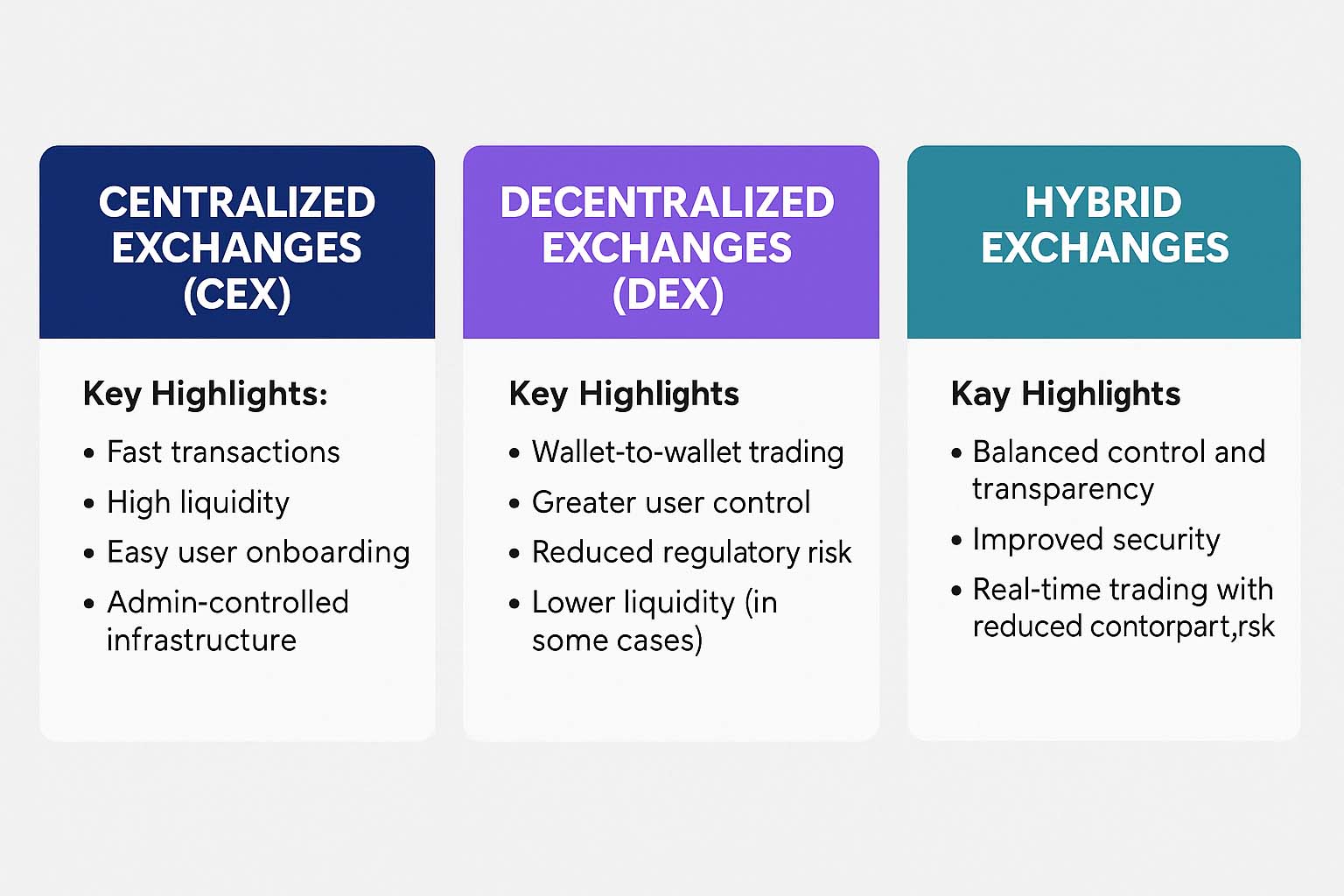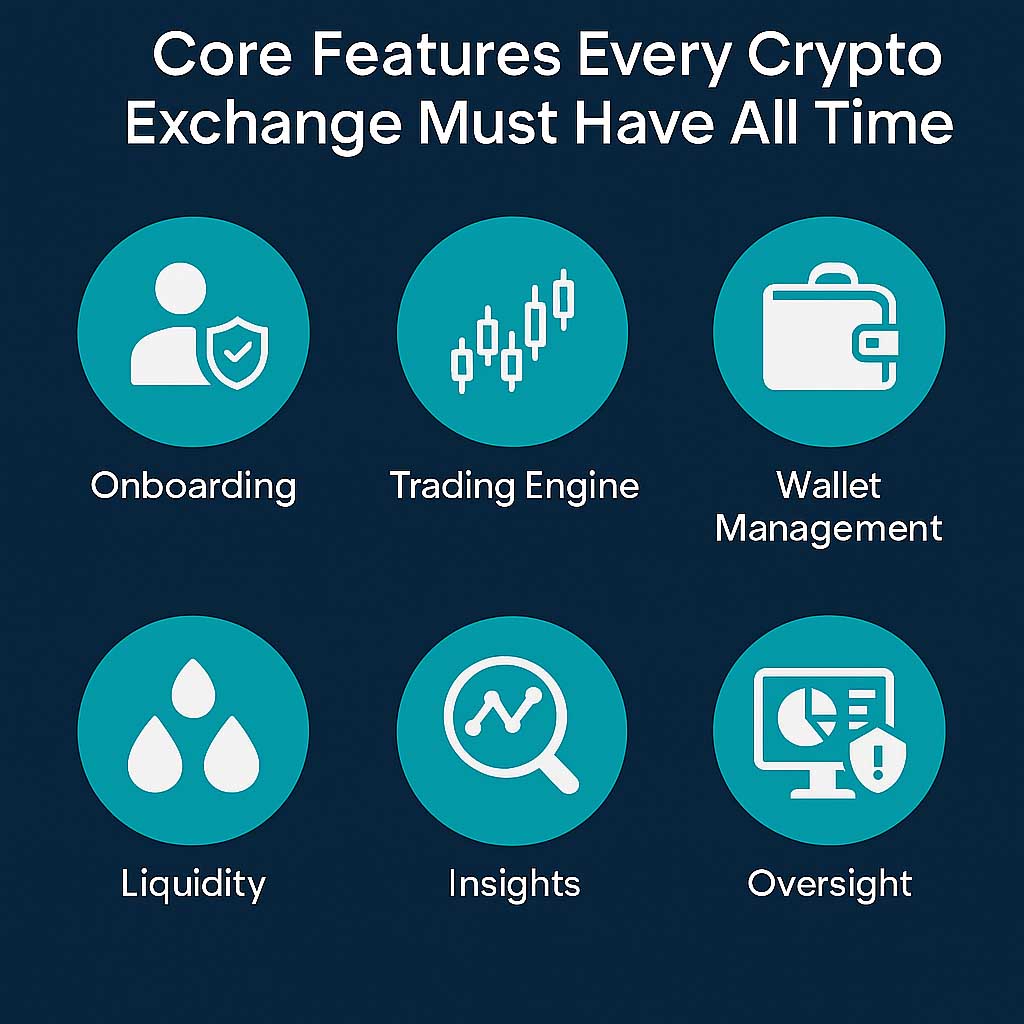The Evolution of Cryptocurrency and Exchanges
Cryptocurrency has developed fast as an international economic presence. Since the launch of Bitcoin in 2009, the crypto ecosystem has grown into a trillion-dollar economy. At the center of this revolution is the cryptocurrency exchange: the cyber infrastructure that facilitates users to purchase, sell, trade, and invest in digital currencies safely.
Whether it's retail traders seeking fast transactions or institutional investors looking for high liquidity, crypto exchanges serve as the gateway into the decentralized financial world. These platforms have become essential bridges between fiat and crypto.
As the popularity of cryptocurrencies continues to rise, exchanges in 2025 and later will need to enable multi-chain operations with security protocols equivalent to military fortresses. But creating a successful crypto exchange is not all about coding. It's about knowing the infrastructure for newbie users and pro traders alike.
Minding, this blog shall provide you with a comprehensive guide that delves into everything you should know about cryptocurrency exchange development, from the exchange types to the tech stack, compliance issues, and how collaborating with an experienced tech team like Sarvaa Technologies can be the game-changer.
Types of Cryptocurrency Exchanges
The first thing to learn about cryptocurrency exchange development is the various types of exchanges that are available in the market. They each have their own set of features with an emphasis on the target user base. Selecting the appropriate model is of prime importance before proceeding with application development.
Centralized Exchanges (CEX)
Most commonly used are centralized exchanges. In these, there is a central authority that runs the user accounts, wallets, and order matching. They tend to facilitate high-volume trading through fiat conversions. Users have faith in the platform to keep their assets safe and facilitate their transactions, here.
Key Highlights:
- Quick transactions
- High liquidity
- Simple user onboarding
- Admin-managed infrastructure
Centralized control, however, has risk involved. Users may be impacted by hacking, downtime, and regulation issues.
Decentralized Exchanges (DEX)
On the other hand, decentralized exchanges don't have a central authority. Transactions are carried out peer-to-peer through smart contracts on blockchain systems. DEX websites provide users with more control and privacy but sometimes have an elementary difficulty to navigate.
Key Highlights:
- Wallet-to-wallet trading
- Increased user control
- Less regulatory risk
- Less liquidity (in certain situations)
So, DEXs are perfect for blockchain-knowing users who want more privacy than security.
Hybrid Exchanges
Hybrid exchanges integrate the advantages of both CEX and DEX models. Such platforms try to deliver the security and control systems with user transparency with the speed and liquidity of the centralized systems.
Key Highlights:
- Balanced control and transparency
- Enhanced security
- Real-time trade with minimum counterparty risk
Hybrid models are gaining momentum as user demand increases in 2025. They are a next-generation solution for companies looking to cater to a mass audience with different levels of crypto knowledge.
Knowledge of these models contributes to what your exchange needs to look like in the market. The second step is understanding what aspects will make it competitive in an ever-evolving environment.

Core Features Every Crypto Exchange Must Have
In the era of competition, opening a crypto exchange is not merely being live—it's standing out. Since user expectations are increasing, your platform must provide more than vanilla trading capabilities. To be successful, it must provide a seamless experience. This starts with the fundamental capabilities that characterize a modern exchange.
1. User Onboarding
Security starts at the user point of entry. Exchanges need to have multi-factor authentication (MFA) and incorporate Know Your Customer (KYC) procedures. These capabilities secure user accounts as well as provide support for compliance with anti-money laundering (AML) laws.
2. Powerful Trading Engine
The trading engine is the pulse of your exchange. It handles orders, matches buyers with sellers, and makes sure that transactions are carried out efficiently. A high-throughput engine is crucial, particularly during busy trading periods when milliseconds count.
3. Real-Time Wallet Management
All transactions need to accommodate both hot wallets for fast transactions and cold wallets for secure, long-term storage. Members need to be able to send and receive digital assets in real time while being able to handle a variety of currencies in a user-friendly dashboard.
4. Liquidity Management System
Liquidity is what draws in traders. Having external liquidity providers integrated or building an in-house liquidity pool facilitates smoother trading experiences. It also minimizes slippage, which is a concern among seasoned traders.
5. Sophisticated Insights
Professional traders require access to sophisticated charts, technical analysis tools, and historical data. Real-time market feeds, order book depth graphics, and customizable interfaces assist users in making informed decisions simultaneously enhance platform stickiness.
6. Admin Panel
For operators of a platform, a robust admin panel is imperative. It must provide insight into all application activities all from a single dashboard for easy management.
7. Push Notification Alerts
Keeping users informed with timely alerts about trades, price movements, and security updates.
Incorporating such features during development ensures that your exchange is not only functional but future-ready. In the next section, we’ll cover how to keep these systems safe with leading security practices.

Best Practices for Security Standards
In the cryptocurrency space, security is not a feature; security is the foundation. With millions of dollars of transactions on a daily basis, crypto exchanges are the first line of attack for scammers. One weak link can result in catastrophic losses. That's why strong security protocols must be built in.
1. Encryption Protocols
Data in transit as well as data at rest should be secured through robust encryption algorithms such as AES-256 and TLS 1.3. This will ensure the sensitive user data, such as login details, cannot be accessed without authorization.
2. Two-Factor Authentication (2FA)
2FA is now a minimum requirement. Through its insistence on an additional authentication factor such as SMS, authenticator apps, or biometric authentication; transactions can substantially cut down on the risk of account compromise even if credentials have been stolen.
3. Cold & Hot Wallet Management
Best practice suggests having most of the user balance in cold wallets, i.e., keeping them offline. Only a small amount required for current trading should be in hot wallets. The movement of wallets should be audited on a regular basis.
4. DDoS Protection
DDoS attacks can ruin a platform within minutes. Rate limiting, traffic filtering, and cloud-based firewalls are a must to counter such threats.
5. Anti-Phishing Tools
Phishing is still a primary threat. Exchanges can institute authentication which warns users of suspected phishing. Informing users by way of notices and tutorials within the platform also fortifies defense.
6. Automated Security Audits
Security is not a one-off activity. Platforms need to have a regular auditing. Several successful exchanges also have bug bounty programs, with requests for ethical hackers to report vulnerabilities before malicious users happen upon them.
7. Regulatory Compliance
Following AML, GDPR, and country-specific crypto regulations isn’t just about legality—it’s about user trust. A compliant platform not only avoids fines but also builds credibility with users.

Cost Factors and Revenue Strategies
Developing and operating a cryptocurrency exchange platform is not only about the tech, it's also about clever budgeting and long-term sustainable revenue streams. Whether you're a startup looking to get into the market or a business growing your current platform, knowing the financials is vital for long-term success.
💰 Exchange Development Cost Factors
1. Development Expenses
The expense of coding, designing, testing, and deploying a crypto exchange varies based on:
- Complexity of features (e.g., multi-currency functionality, trading engine, admin panel)
- Type of exchange (centralized vs. decentralized)
- In-house team vs. outsourced development
- Native mobile app inclusion
💡 Tip: Collaborating with an experienced team such as Sarvaa Technologies shortens
development time and reduces risk.
2. Security Infrastructure
Security is an invariable cost factor. Costs may be:
- Advanced firewall & DDoS protection
- Multi-signature wallet deployment
- Security penetration testing
- Ongoing compliance monitoring tools
3. Third-party Integrations
Costs depend on:
- Payment gateway partnerships
- Liquidity provider fees
- AML/KYC verification services
- Blockchain node providers
Every integration is more convenient, but has recurring costs.
4. Hosting
Hosting on scalable cloud infrastructure such as AWS or GCP provides 24/7 uptime, low-latency performance, and worldwide availability. DevOps budgeting for server auto-scaling, backups, and failover systems must be planned.
💸 Revenue Strategies for Crypto Exchanges
After going live, your platform will need to provide regular revenue streams. Typical monetization models are:
1. Trading Fees
This is the main source of income. Exchanges usually charge:
- Maker & taker fees (e.g., 0.1%–0.25%)
- Tiered fee scales depending on trading volume
✅ Pro Tip: Fees reduce volume, while VIP levels promote loyalty.
2. Listing Fees
Crypto ventures pay to have their coins/tokens listed on well-established exchanges. Depending on how many users the platform has, this can be a significant revenue source.
3. Withdrawal & Deposit Fees
It's essential to charge small fees for fiat/crypto withdrawals and deposits to help maintain transaction and gas fees. These must be made clear.
4. Margin Trading
Margin trading is provided by advanced exchanges where the users can borrow to trade with leverage. It provides opportunities for:
- Interest on loans
- Liquidation fees on margin positions
5. Staking & Yield Services
Allowing staking options for supported coins enables users to earn passive income and enables the exchange to:
- Charge a commission on rewards
- Encourage users to leave assets on the platform longer
6. Premium Accounts Facility
Provide subscription-based features:
- High-speed trading APIs
- Priority customer support
- Custom dashboard setups
UX/UI Design & Customer Experience – The Quiet Differentiator
In today's saturated crypto market, where dozens of new platforms enter the scene each year, user experience (UX) and user interface (UI) design have emerged as essential differentiators. It's no longer sufficient to provide only trading capability; what's important is how seamlessly users can engage with your platform.
A clean, responsive, and intuitive UI increases user retention, decreases support tickets, and leads to more transactions. From a first-time user discovering crypto to an expert trader placing complex orders, experience design is a significant contributor to engagement.
🎯 Why UX/UI is Important in Crypto Exchanges
- Establishes Trust: Clear design with easy navigation creates user trust.
- Reduces Friction: An elegantly designed interface avoids confusion, particularly in complex operations such as deposits or order placing.
- Increases Transactions: The simpler the trading, the more users are likely to remain with your services.
📱 Example: A feature for one-click crypto buying with visual aid can double the engagement versus standard multi-step procedures.
🧩 Key UX/UI Features to Implement
1. Streamlined Onboarding
Rapid registration, smooth KYC process, and step-by-step guided interactions can substantially enhance initial impressions.
Introduce visual indications, tooltips, and status markers upon user verification.
2. Clean Trading Dashboard
Show live charts, order books, and wallet balances on a clean, customizable basis. Support switching between basic and advanced views for various user types.
3. Mobile-First Experience
As more people adopt crypto through smartphones, mobile-optimization is a must.
4. Personalization
User preferences such as theme switching, layout adjustment, and watchlists make the personal experience better.
5. Live Support Integration
Chatbots widgets with live support improve user satisfaction.
💡 Designing for Accessibility and Inclusivity
Make sure your platform accommodates diverse user needs, including:
- Keyboard navigation
- Screen reader support
- High-contrast themes
- Language localization for global users
🔄 Continuous UX Optimization
UX design is not “set and forget.” Regular usability testing, A/B experiments, and user feedback collection help evolve your design based on actual behavior.
Sarvaa Technologies focuses on data-backed UX improvements that enhance usability and conversion rates across devices.
A strong trading engine is of little significance if your users cannot easily interact with your platform. Outstanding results in UX/UI are the first line of your brand experience.
Putting It All Together – The Sarvaa Technologies Advantage 🛠️🚀
Creating a prosperous cryptocurrency exchange is all about marrying vision, technology, security, user requirements, and legal conformance into an extensionless system. This is where Sarvaa Technologies comes in. We might be your development partner; a strategic partner for your venture to launch your crypto marketplace.
🏗️ End-to-End Development
From inception to rollout, Sarvaa Technologies provides:
- Tailored exchange platforms: Centralized, decentralized, hybrid
- Custom trading engines with high-speed matching algorithms
- Multi-asset wallet integrations (cold/hot wallet balance)
- Blockchain nodes configuration and third-party APIs
There's no need to deal with several vendors. We manage it all under one roof.
🛡️ Built-In Security and Compliance
Security isn't a choice—it's our starting point. With Sarvaa, your platform is pre-configured with:
- 2FA and biometric authentication
- Automated KYC/AML workflows
- DDoS and anti-phishing protection
- Ongoing audits, penetration testing & DevSecOps
We make sure your platform is up to the highest standards worldwide, starting from GDPR to VASP guidelines.
🎨 Custom UX/UI with Conversion in Mind
We build powerful yet intuitive platforms.
From the dashboard design, or customized user flows, we make each screen yield engagement and conversion.
💡 Bonus: Our designers leverage behavior-driven design to align with your user flow, boosting sign-ups while lessening drop-offs.
📈 Growth-Ready Infrastructure
We launch product-ready for the future.
Sarvaa Technologies develops your exchange with:
- Cloud-native microservices
- Containerization using Docker/Kubernetes
- Elastic scalability to handle traffic spikes
- Built-in analytics dashboards
As you expand your user base, your platform grows without resistance.
🤝 Why Do Business with Sarvaa Technologies?
- Established expertise in blockchain, fintech, and security-based systems
- Quick development cycles with open reporting
- An available-to-scale team of analysts, developers, and QA professionals
- Post-launch maintenance, update, and growth support
Above all—we don't simply create products. We create partnerships built on trust.
✅ Ready to Launch?
Whether you're a fintech startup, an enterprise innovating in Web3, or a crypto exchange launching your venture, Sarvaa Technologies assists you in launching your crypto exchange confidently.
📩 Launch today → www.sarvaatechnologies.com/contact-us






